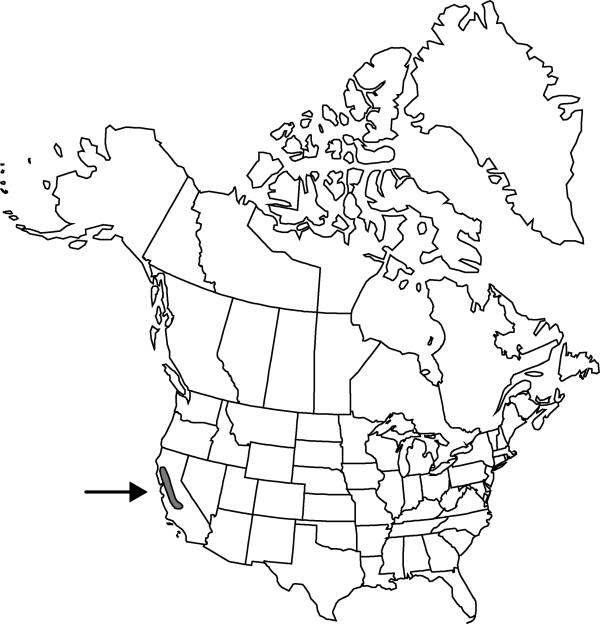Difference between revisions of "Atriplex parishii var. persistens"
Rhodora 102: 423. 2001.
FNA>Volume Importer |
FNA>Volume Importer |
||
| Line 28: | Line 28: | ||
|distribution=Calif. | |distribution=Calif. | ||
|discussion=<p>Of conservation concern.</p><!-- | |discussion=<p>Of conservation concern.</p><!-- | ||
| − | --><p>Atriplex depressa var. persistens grows with Atriplex fruticulosa, A. rosea, Downingia bella, Lasthenia fremontii, Cressa truxillensis, Eryngium castrense, Frankenia grandiflora, Psilocarpus brevissimus, other annual species, and Distichlis spicata. This taxon, with its persistent, thickened fruiting bracteoles, is probably most nearly allied to var. subtilis, which likewise has clinging fruiting bracteoles and at least a tendency toward concentration of staminate flowers at branch ends. Although it was described as having alternate leaves, a specimen from nearby the type locality, Hall 11006 (GH) taken in July of 1920, has leaves and foliose bracts of inflorescence clearly opposite. A note on the label of Hall 11759 (GH) states, “one plant with mostly opposite lvs; others with lvs. mostly alternate but a few on same plant plainly opposite.”</p> | + | --><p><i>Atriplex</i> depressa <i></i>var.<i> persistens</i> grows with <i>Atriplex fruticulosa</i>, <i>A. rosea</i>, Downingia bella, <i>Lasthenia fremontii</i>, Cressa truxillensis, Eryngium castrense, <i>Frankenia</i> grandiflora, Psilocarpus brevissimus, other annual species, and <i>Distichlis spicata</i>. This taxon, with its persistent, thickened fruiting bracteoles, is probably most nearly allied to <i></i>var.<i> subtilis</i>, which likewise has clinging fruiting bracteoles and at least a tendency toward concentration of staminate flowers at branch ends. Although it was described as having alternate leaves, a specimen from nearby the type locality, Hall 11006 (GH) taken in July of 1920, has leaves and foliose bracts of inflorescence clearly opposite. A note on the label of Hall 11759 (GH) states, “one plant with mostly opposite lvs; others with lvs. mostly alternate but a few on same plant plainly opposite.”</p> |
|tables= | |tables= | ||
|references= | |references= | ||
| Line 52: | Line 52: | ||
|publication year=2001 | |publication year=2001 | ||
|special status= | |special status= | ||
| − | |source xml=https://jpend@bitbucket.org/aafc-mbb/fna-data-curation.git/src/ | + | |source xml=https://jpend@bitbucket.org/aafc-mbb/fna-data-curation.git/src/8f726806613d60c220dc4493de13607dd3150896/coarse_grained_fna_xml/V4/V4_694.xml |
|genus=Atriplex | |genus=Atriplex | ||
|subgenus=Atriplex subg. Obione | |subgenus=Atriplex subg. Obione | ||
Revision as of 17:30, 18 September 2019
Stems erect or ascending, 1–2 dm; branches crowded, spreading, scurfy. Leaves alternate or opposite (within populations or on same plant), sessile; blade gray-green, ovate to ovate-lanceolate, 2–4 × 1–3 mm, base cuneate to subcordate, margin entire, apex shortly acuminate, scurfy on both surfaces; bracteate leaves opposite or subopposite, some long villous hairs sometimes present. Staminate flowers in axillary glomerules near branch apices and/or in terminal spikes 0.5–4 cm, 4–5-merous; anthers reddish purple. Pistillate flowers commonly solitary in axils below staminate inflorescences or intermixed. Fruiting bracteoles persistent, ovate-oblong, slightly compressed, 3–4 × 2.5–3.5(–4) mm, hardened to middle, with 1–2 irregular tuberculate appendages on each face, densely scurfy. Seeds red-brown, 1.2–1.5 mm wide.
Phenology: Flowering spring–fall.
Habitat: Saline or alkaline depressions or vernal pools
Elevation: 0-100 m
Discussion
Of conservation concern.
Atriplex depressa var. persistens grows with Atriplex fruticulosa, A. rosea, Downingia bella, Lasthenia fremontii, Cressa truxillensis, Eryngium castrense, Frankenia grandiflora, Psilocarpus brevissimus, other annual species, and Distichlis spicata. This taxon, with its persistent, thickened fruiting bracteoles, is probably most nearly allied to var. subtilis, which likewise has clinging fruiting bracteoles and at least a tendency toward concentration of staminate flowers at branch ends. Although it was described as having alternate leaves, a specimen from nearby the type locality, Hall 11006 (GH) taken in July of 1920, has leaves and foliose bracts of inflorescence clearly opposite. A note on the label of Hall 11759 (GH) states, “one plant with mostly opposite lvs; others with lvs. mostly alternate but a few on same plant plainly opposite.”
Selected References
None.
